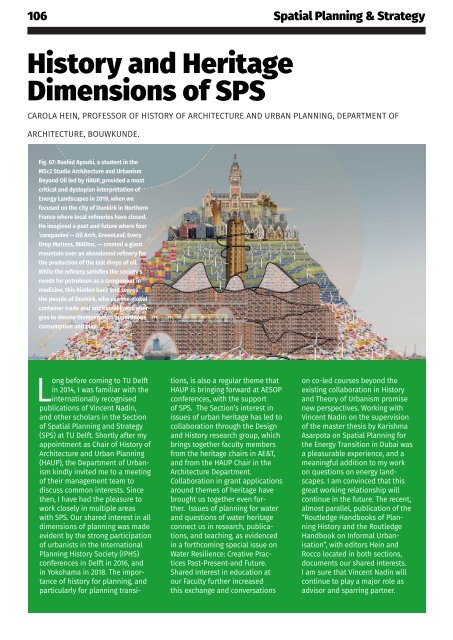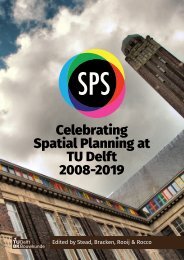*Celebrating Spatial Planning at TU Delft: 2008-2019. Edited by Stead, Bracken, Rooij & Rocco
This is a summary of the achievements of the session Spatial Planning & Strategy of the Department of Urbanism, Faculty of Architecture and the Built Environment, TU Delft, led by Professor Vincent Nadin between 2008 and 2019.
This is a summary of the achievements of the session Spatial Planning & Strategy of the Department of Urbanism, Faculty of Architecture and the Built Environment, TU Delft, led by Professor Vincent Nadin between 2008 and 2019.
Create successful ePaper yourself
Turn your PDF publications into a flip-book with our unique Google optimized e-Paper software.
106 <strong>Sp<strong>at</strong>ial</strong> <strong>Planning</strong> & Str<strong>at</strong>egy<br />
History and Heritage<br />
Dimensions of SPS<br />
CAROLA HEIN, PROFESSOR OF HISTORY OF ARCHITEC<strong>TU</strong>RE AND URBAN PLANNING, DEPARTMENT OF<br />
ARCHITEC<strong>TU</strong>RE, BOUWKUNDE.<br />
Fig. 67: Rashid Ayoubi, a student in the<br />
MSc2 Studio Architecture and Urbanism<br />
Beyond Oil led <strong>by</strong> HAUP, provided a most<br />
critical and dystopian interpret<strong>at</strong>ion of<br />
Energy Landscapes in 2019, when we<br />
focused on the city of Dunkirk in Northern<br />
France where local refineries have closed.<br />
He imagined a past and future where four<br />
‘companies’— Oil Arch, GreenLeaf, Every<br />
Drop M<strong>at</strong>ters, MADInc. — cre<strong>at</strong>ed a giant<br />
mountain over an abandoned refinery for<br />
the production of the last drops of oil.<br />
While the refinery s<strong>at</strong>isfies the society’s<br />
needs for petroleum as a component in<br />
medicine, this hidden back end serves<br />
the people of Dunkirk, who use the global<br />
container trade and additional green energies<br />
to devote themselves to superfluous<br />
consumption and play.<br />
Long before coming to <strong>TU</strong> <strong>Delft</strong><br />
in 2014, I was familiar with the<br />
intern<strong>at</strong>ionally recognised<br />
public<strong>at</strong>ions of Vincent Nadin,<br />
and other scholars in the Section<br />
of <strong>Sp<strong>at</strong>ial</strong> <strong>Planning</strong> and Str<strong>at</strong>egy<br />
(SPS) <strong>at</strong> <strong>TU</strong> <strong>Delft</strong>. Shortly after my<br />
appointment as Chair of History of<br />
Architecture and Urban <strong>Planning</strong><br />
(HAUP), the Department of Urbanism<br />
kindly invited me to a meeting<br />
of their management team to<br />
discuss common interests. Since<br />
then, I have had the pleasure to<br />
work closely in multiple areas<br />
with SPS. Our shared interest in all<br />
dimensions of planning was made<br />
evident <strong>by</strong> the strong particip<strong>at</strong>ion<br />
of urbanists in the Intern<strong>at</strong>ional<br />
<strong>Planning</strong> History Society (IPHS)<br />
conferences in <strong>Delft</strong> in 2016, and<br />
in Yokohama in 2018. The importance<br />
of history for planning, and<br />
particularly for planning transitions,<br />
is also a regular theme th<strong>at</strong><br />
HAUP is bringing forward <strong>at</strong> AESOP<br />
conferences, with the support<br />
of SPS. The Section’s interest in<br />
issues of urban heritage has led to<br />
collabor<strong>at</strong>ion through the Design<br />
and History research group, which<br />
brings together faculty members<br />
from the heritage chairs in AE&T,<br />
and from the HAUP Chair in the<br />
Architecture Department.<br />
Collabor<strong>at</strong>ion in grant applic<strong>at</strong>ions<br />
around themes of heritage have<br />
brought us together even further.<br />
Issues of planning for w<strong>at</strong>er<br />
and questions of w<strong>at</strong>er heritage<br />
connect us in research, public<strong>at</strong>ions,<br />
and teaching, as evidenced<br />
in a forthcoming special issue on<br />
W<strong>at</strong>er Resilience: Cre<strong>at</strong>ive Practices<br />
Past-Present-and Future.<br />
Shared interest in educ<strong>at</strong>ion <strong>at</strong><br />
our Faculty further increased<br />
this exchange and convers<strong>at</strong>ions<br />
on co-led courses beyond the<br />
existing collabor<strong>at</strong>ion in History<br />
and Theory of Urbanism promise<br />
new perspectives. Working with<br />
Vincent Nadin on the supervision<br />
of the master thesis <strong>by</strong> Karishma<br />
Asarpota on <strong>Sp<strong>at</strong>ial</strong> <strong>Planning</strong> for<br />
the Energy Transition in Dubai was<br />
a pleasurable experience, and a<br />
meaningful addition to my work<br />
on questions on energy landscapes.<br />
I am convinced th<strong>at</strong> this<br />
gre<strong>at</strong> working rel<strong>at</strong>ionship will<br />
continue in the future. The recent,<br />
almost parallel, public<strong>at</strong>ion of the<br />
“Routledge Handbooks of <strong>Planning</strong><br />
History and the Routledge<br />
Handbook on Informal Urbanis<strong>at</strong>ion”,<br />
with editors Hein and<br />
<strong>Rocco</strong> loc<strong>at</strong>ed in both sections,<br />
documents our shared interests.<br />
I am sure th<strong>at</strong> Vincent Nadin will<br />
continue to play a major role as<br />
advisor and sparring partner.




